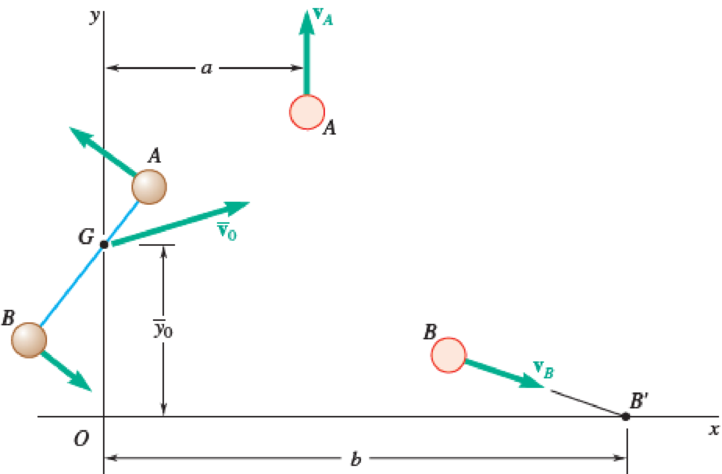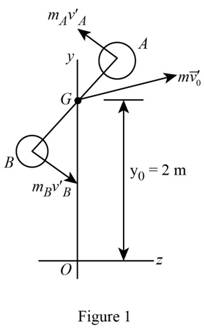
Two small disks A and B of mass 3 kg and 1.5 kg, respectively, may slide on a horizontal, frictionless surface. They are connected by a cord, 600 mm long, and spin counterclockwise about their mass center G at the rate of 10 rad/s. At t = 0, the coordinates of G are
Fig. P14.53 and P14.54

(a)
Find the velocity of A and B after the cord breaks.
Answer to Problem 14.53P
The velocity of A after the cord breaks is
The velocity of B after the cord breaks is
Explanation of Solution
Given information:
The mass
The mass
The cord length AB is
The rate of spin
The coordinates of G,
The velocity
The distance b is
Calculation:
Sketch the disk A and B as shown in Figure 1.

Refer to Figure 1.
The small disks A and B of mass
At location G,
Find the total mass (m) using the relation as follows:
Substitute
Substitute
Find the linear momentum using the relation as follows:
Substitute
Find the angular moment about G using the equation as follows:
Substitute
Find the angular moment about G using the equation as follows:
Refer problem 14.27,
Substitute
Find the kinetic energy
Refer to equation 14.29 in section 14.2A Kinetic energy of a System of particles in the textbook.
Substitute
Sketch the system as shown in Figure 2.

Write the conservation of linear momentum as follows:
Substitute
Substitute
Equate the coefficient i as follows:
Equate the coefficient j as follows:
Express the conservation of energy as follows:
Find the velocity
Substitute
Substitute
Apply the quadratic formula as follows:
Substitute 1 for a, 1.92 for b, and
Thus, the velocity of A after the cord breaks is
Find the velocity
Substitute
The velocity
Find the velocity
Thus, the velocity of B after the cord breaks is
(b)
Find the distance a from the y axis to the path of A.
Answer to Problem 14.53P
The distance a from the y axis to the path of A is
Explanation of Solution
Calculation:
Find the distance a from the y axis to the path of A using the relation:
Substitute
Substitute
Thus, the distance a from the y axis to the path of A is
Want to see more full solutions like this?
Chapter 14 Solutions
Vector Mechanics for Engineers: Statics and Dynamic
- A hoop of radius 95mm and mass 100g is rotated via a capacitor driven power source with P(t)=1.61e-1.3tW. (since it is a hoop, it is a special case, and r=rG) Assuming the hoop is accelerated from rest, determine the rotational velocity after t=8.5s. [rad.s-1] Determine the rotational speed of the hoop after t=8.5s if the power source acts to roll the particle from rest on a horizontal surface. [rad.s-1]arrow_forwardTwo identical giant flywheels are on 2 identical slopes at an angle alpha = 20 deg. One flywheel is rolling on its inside shaft of diameter d1 = 3 ft, and the second flywheel is rolling without slipping on its outside diameter d2 = 5 ft. They are both released from rest. The weight of the flywheel is W = 8 lbs 1. Knowing that flywheel 1 attains a speed of v = 7.0 ft/s in t = [t] s, (if t doesn't show take any t between 5 and 10 sec) find the radius of gyration of the flywheels, following those steps: 3. What will be the distance between the 2 flywheels? Which one is in front? a. Explain your strategy to find the distance made by each wheel. b. Find the 3 distances made by each wheel. c. Find the distance between the 2 flywheels. d. Why one is in front? 4. Using flywheel 2, what is the coefficient of static friction between the outside diameter and the ground required to prevent slipping? a. Using the 3 previous diagrams, which impulse will you consider finding the force of…arrow_forwardQUESTION: A bowling ball ( m₁ = 3.00 kg and radius of r = 50.0 mm) which has an angular and linear velocity of 57.1 rad/s and 2.85 m/s, respectively, rolls without sliding and hits a slender Bar B of mass m_2 = 1.00 kg and length L = 0.12 m, which is initially at rest as shown in the following figure. Neglecting the friction between the sphere and the bar, and knowing the coefficient of restitution between the sphere and the bar is 0.2, determine (1) the angular velocity of Sphere A and Bar B immediately after impact, and (2) the linear velocities of sphere A and bar B immediately after impact (and at their centroids). ANSWER: Answers I got are: (they are wrong :< need help) Angular velocity of Sphere A immediately after impact: -/+ 3.34 rad/s (both are wrong) Angular velocity of Bar B immediately after impact: 8.09 rad/s The linear velocity of sphere A immediately after impact (and at the centroid) : 0.16 rad/s2 or 0.485 rad/s2 (both wrong) The linear velocity of Bar B…arrow_forward
- A cyclist is riding a bicycle at a speed of 20 mph on a horizontal road. The distance between the axles is 42 in., and the mass center of the cyclist and the bicycle is located 26 in. behind the front axle and 40 in. above the ground. If the cyclist applies the brakes only on the front wheel, determine the shortest distance in which he can stop without being thrown over the front wheel.arrow_forwardTwo identical giant flywheels are on 2 identical slopes at an angle alpha = 20 deg. One flywheel is rolling on its inside shaft of diameter d1 = 3 ft, and the second flywheel is rolling without slipping on its outside diameter d2 = 5 ft. They are both released from rest. The weight of the flywheel is W = 8 lbs Knowing that flywheel 1 attains a speed of v = 7.0 ft/s in t = [t] s, (if t doesn't show take any t between 5 and 10 sec) find the radius of gyration of the flywheels, following those steps: b. Find omega final c. Find the angular impulse at the point of contact between the shaft and the slope. d. Write the formula to find the final momentum. e. Solve for k, using the principle of angular impulse and momentumarrow_forwardEnds of three light identical rods each of length l are connected to a light pivot that enables them to rotate in any direction. At the other ends of the rods, three particles A, B and C of masses m, 2m and 3m respectively are affixed. Initially the rods are coplanar, angle between any two is 120 and the particles are at rest. Now the particle C is given a velocity u perpendicular to the rod connected to it and in the plane of the rods as shown in the figure. Ignore gravitational interaction between the particles. What are the moduli of acceleration of the particles A, B and C immediately after the particle C is given velocity u?arrow_forward
- A 1024-kg blue ball is dropped from an initial z-position of 5.4 x 106 m through the center of a planet with radius 6.3 x 106 m. If the mass of the planet is 37.7 x 1015 kg, measure the displacement of the ball at time t = 5 s?arrow_forwardTwo smooth disks A and B each have a mass of 0.5 kg. Both disks are moving with the velocities shown when they collide. Suppose that (vA)1 = 9 m/s , (vB)1 = 8 m/s. The figure shows two discs, A and B, moving toward the origin of a horizontal xy-plane, where they collide, so that their common tangent lies on y-axis. Disk A moves in negative x-direction with velocity left-parenthesis v subscript A right-parenthesis subscript 1. Block B moves from the third quarter with velocity left-parenthesis v subscript B right-parenthesis subscript 1, directed along an inclined line with a slope of four-thirds. Determine the coefficient of restitution between the disks if after collision B travels along a line, 30∘ counterclockwise from the y axis.arrow_forwardA bowling ball ( m₁ = 3.00 kg and radius of r = 50.0 mm) which has an angular and linear velocity of 57.1 rad/s and 2.85 m/s, respectively, rolls without sliding and hits a slender Bar B of mass m_2 = 1.00 kg and length L = 0.12 m, which is initially at rest as shown in the following figure. Neglecting the friction between the sphere and the bar, and knowing the coefficient of restitution between the sphere and the bar is 0.2, determine (1) the angular velocity of Bar B immediately after impact, and (2) the linear velocities of sphere A and bar B immediately after impact (and at their centroids).arrow_forward
- A 1.8-kg collar A and a 0.7-kg collar B can slide without friction on a frame, consisting of the horizontal rod OE and the vertical rod CD, which is free to rotate about its vertical axis of symmetry. The two collars are connected by a cord running over a pulley that is attached to the frame at O. At the instant shown, the velocity vA of Collar A has a magnitude of 2.1 m/s and a stop prevents collar B from moving. The stop is suddenly removed and collar A moves toward E. As it reaches a distance of 0.12 m from, the magnitude of its velocity is observed to be 2.5 m/s. Determine at that instant the magnitude of the angular velocity of the frame and the moment of inertia of the frame and pulley system about CD.arrow_forwardCalculate the kinetic energy loss in a perfectly inelastic collision between an object of mass 40kg with velocity 8m/s and an object of mass 60kg coming in the opposite direction with velocity 2m/s.arrow_forwardTwo beads of mass m are initially at rest at the top of a frictionless hoop of mass M and radius R, which stands vertically on the ground. The beads, being strung on the hoop, are constrained to move along the hoop’s circular path. The beads are given tiny kicks, and they slide down the hoop, one to the right and one to the left. What is the largest value of m/M for which the hoop never rises up off the ground? (Given a sufficiently large ratio of m/M the normal force of the beads on the hoop can indeed cause it to jump off of the ground!) Some thoughts/hints about this problem:(a) It is important to think about the direction of the Normal force as the beads move around the hoop. The hoop is exerting a normal force on the beads which are constraining them to stay on the wire as they move around the hoop. The beads are also exerting a normal force on the hoop which is what will make the hoop jump.(b) What happens to the direction of the normal force exerted by the hoop on the beads as…arrow_forward
 Elements Of ElectromagneticsMechanical EngineeringISBN:9780190698614Author:Sadiku, Matthew N. O.Publisher:Oxford University Press
Elements Of ElectromagneticsMechanical EngineeringISBN:9780190698614Author:Sadiku, Matthew N. O.Publisher:Oxford University Press Mechanics of Materials (10th Edition)Mechanical EngineeringISBN:9780134319650Author:Russell C. HibbelerPublisher:PEARSON
Mechanics of Materials (10th Edition)Mechanical EngineeringISBN:9780134319650Author:Russell C. HibbelerPublisher:PEARSON Thermodynamics: An Engineering ApproachMechanical EngineeringISBN:9781259822674Author:Yunus A. Cengel Dr., Michael A. BolesPublisher:McGraw-Hill Education
Thermodynamics: An Engineering ApproachMechanical EngineeringISBN:9781259822674Author:Yunus A. Cengel Dr., Michael A. BolesPublisher:McGraw-Hill Education Control Systems EngineeringMechanical EngineeringISBN:9781118170519Author:Norman S. NisePublisher:WILEY
Control Systems EngineeringMechanical EngineeringISBN:9781118170519Author:Norman S. NisePublisher:WILEY Mechanics of Materials (MindTap Course List)Mechanical EngineeringISBN:9781337093347Author:Barry J. Goodno, James M. GerePublisher:Cengage Learning
Mechanics of Materials (MindTap Course List)Mechanical EngineeringISBN:9781337093347Author:Barry J. Goodno, James M. GerePublisher:Cengage Learning Engineering Mechanics: StaticsMechanical EngineeringISBN:9781118807330Author:James L. Meriam, L. G. Kraige, J. N. BoltonPublisher:WILEY
Engineering Mechanics: StaticsMechanical EngineeringISBN:9781118807330Author:James L. Meriam, L. G. Kraige, J. N. BoltonPublisher:WILEY





